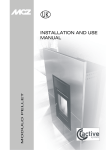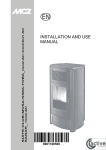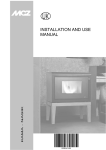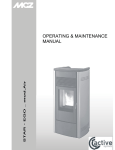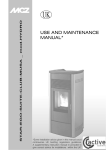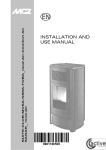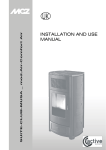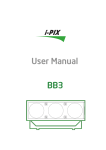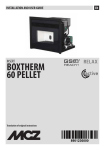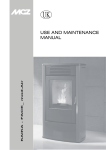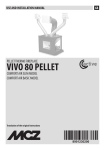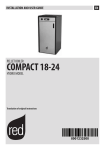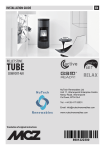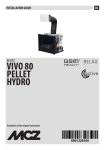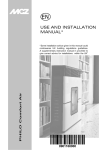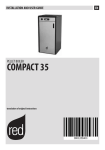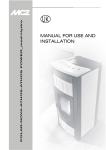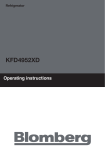Download Product Brochure
Transcript
USE AND MAINTENANCE MANUAL* 8901134300 *Some installation advice given in this manual could contravenes UK building regulations guidelines. A supplementary instruction manual in provided to give correct advice for installations within the UK” PELLET STOVES INSTALLATION AND USE MANUAL Contents page 2 INTRODUCTION .................................................................................................................................... 4 1. WARNINGS AND GUARANTEE CONDITIONS ..................................................................................... 5 1.1. SAFETY INSTRUCTIONS .................................................................................................................... 5 1.2. OPERATING WARNINGS .................................................................................................................... 6 1.3. GUARANTEE CONDITIONS ................................................................................................................ 7 1.3.1. Limitations ................................................................................................................................. 7 1.3.2. Exclusions.................................................................................................................................. 7 2. THEORETICAL NOTIONS FOR INSTALLATION ................................................................................... 9 2.1. 2.2. 2.3. 2.4. 2.5. 2.6. 2.7. 2.8. 2.9. Pellets .............................................................................................................................................. 9 PRECAUTIONS FOR INSTALLATION ................................................................................................. 10 OPERATING AREA........................................................................................................................... 11 CONNECTION TO THE EXTERNAL AIR INTAKE ................................................................................. 11 CONNECTION OF SMOKE DISCHARGE PIPE...................................................................................... 12 CONNECTION TO THE FLUE PIPE .................................................................................................... 13 CONNECTION TO AN EXTERNAL FLUE WITH INSULATED OR DOUBLE-WALL PIPE .............................. 13 CONNECTION TO THE FLUE PIPE .................................................................................................... 13 OPERATING PROBLEMS CAUSED BY DRAUGHT DEFECTS IN THE FLUE .............................................. 14 3. INSTALLATION AND ASSEMBLY ...................................................................................................... 15 3.1. DRAWINGS AND TECHNICAL CHARACTERISTICS.............................................................................. 15 3.1.1. STAR Air – Comfort Air ............................................................................................................. 15 3.1.2. EGO Air – Comfort Air............................................................................................................... 16 3.1.3. Technical characteristics ........................................................................................................... 17 3.2. PREPARATION AND UNPACK ING .................................................................................................... 18 3.3. LATERAL CLADDING ASSEMBLY ....................................................................................................... 20 3.4. HOT AIR DUCTING CONNECTION ON EGO AND STAR COMFORT AIR MODELS ................................... 22 3.5. INSTALLATION OF AIR FILTER ........................................................................................................ 24 3.6. MAKING THE ELECTRICAL CONNECTIONS ....................................................................................... 24 4. OPERATION ..................................................................................................................................... 25 4.1. PRE-LIGHTING WARNINGS.............................................................................................................. 25 4.2. PRE-LIGHTING CHECK .................................................................................................................... 26 4.3. LOADING THE PELLETS ................................................................................................................... 26 4.4. CONTROL PANEL/REMOTE CONTROL DISPLAY (accessory) ............................................................... 27 4.4.1. Control panel logic ................................................................................................................... 27 4.4.2. Remote control (accessory) ...................................................................................................... 29 4.4.2.1. General characteristics of the LCD remote control ................................................................ 30 4.4.2.2. Type of batteries and replacement ..................................................................................... 30 4.5. SETTINGS TO CARRY OUT BEFORE FIRST LIGHTING ........................................................................ 30 4.5.1. Setting current day and time..................................................................................................... 31 4.5.2. Setting the language ................................................................................................................ 33 4.6. FIRST LIGHTING............................................................................................................................. 34 4.6.1. ON/OFF from the control panel or remote control (if purchased) ................................................. 34 4.6.2. Note on first ignition ................................................................................................................. 34 4.7. OPERATING MODE ......................................................................................................................... 35 4.7.1. Manual and automatic .............................................................................................................. 35 4.7.1.1. Changing from manual to automatic mode .......................................................................... 35 4.7.2. Manual mode ........................................................................................................................... 35 4.7.3. Automatic mode ....................................................................................................................... 36 4.7.3.1. Room sensor ..................................................................................................................... 36 4.7.3.2. External environment thermostat connection ....................................................................... 37 4.7.4. Automatic mode with AUTO-ECO .............................................................................................. 38 4.7.4.1. Activation /de-activation of AUTO-ECO mode ...................................................................... 39 4.8. HOT AIR VENTILATION ................................................................................................................... 40 Contents Technical service - Rights reserved MCZ GROUP S.p.A. - Reproduction prohibited PELLET STOVES INSTALLATION AND USE MANUAL Contents page 3 4.8.1. COMFORT AIR version .............................................................................................................. 41 4.9. SLEEP FUNCTION ........................................................................................................................... 42 4.10. TIMER ........................................................................................................................................ 42 4.10.1. Current date and clock .......................................................................................................... 42 4.10.2. TIMER activation and selection of a programme. .................................................................... 43 4.10.3. TIMER de-activation. ............................................................................................................. 44 4.11. PRE-SET WEEKLY AND DAILY PROGRAMMES ................................................................................ 44 4.11.1. Weekly programmes ............................................................................................................. 44 4.11.2. Daily programmes ................................................................................................................. 46 4.12. PRACTICAL EXAMPLE OF DAILY PROGRAMMING ........................................................................... 48 4.12.1. Setting of a daily programme ................................................................................................ 48 4.13. SAFETY DEVICES......................................................................................................................... 48 4.14. ALARM SIGNALLING .................................................................................................................... 49 4.15. Exiting alarm condition ................................................................................................................ 51 4.15.1. Shutdown of the stove .......................................................................................................... 51 5. MAINTENANCE AND CLEANING ....................................................................................................... 52 5.1. DAILY AND WEEKLY CLEANING BY THE USER .................................................................................. 52 5.1.1. Before each lighting ................................................................................................................. 52 5.1.2. Check every 2/3 days ............................................................................................................... 52 5.1.3. Cleaning the glass .................................................................................................................... 53 5.1.4. Cleaning of the air filter ............................................................................................................ 53 5.2. PERIODIC CLEANING BY A SPECIALISED TECHNICIAN ..................................................................... 54 5.2.1. Cleaning of the heat exchanger ................................................................................................. 54 5.2.2. Cleaning an Ego/Star Comfort air stove ..................................................................................... 55 5.2.3. Shutting the stove down (end of season) ................................................................................... 56 5.2.4. Check of internal components ................................................................................................... 56 6. PROBLEMS / CAUSES / SOLUTIONS ................................................................................................ 57 7. ELECTRICAL DIAGRAMS .................................................................................................................. 59 Contents Technical service - Rights reserved MCZ GROUP S.p.A. - Reproduction prohibited PELLET STOVES INSTALLATION AND USE MANUAL Chapter 1 page 4 INTRODUCTION Dear Customer, We wish to thank you for choosing an MCZ product, specifically a stove of the MCZ pellet line. In order to get the best performance from your stove and to enjoy to the full the warmth and the sense of well-being which the flame will diffuse through the home, we recommend that you read this booklet carefully before lighting the s tove for the first time. While thanking you again, may we remind you that the stove MUST NOT be used by children, and that they must always be kept at a safe distance from it! Revisions to the publication In order to improve the product, to keep this publication up to date the manufacturer reserves the right to make modifications without any advance notice. Any reproduction, even in part, of this manual without the consent of the manufacturer is prohibited. Care of the manual and how to consult it Take good care of this manual and keep it in a place which can easily and quickly be reached. If this manual should be lost or destroyed, or if it is in poor condition, ask for a copy from your retailer or directly from the manufacturer, providing product identification data. Information which is essential or that requires special attention is shown in bold text. Italic text is used to call your attention to other paragraphs in the manual or for any additional clarifications. SYMBOLS USED IN THE MANUAL ATTENTION This warning sign indicates that the message to which it refers should be carefully read and understood, because failure to comply with what these notices say can cause serious damage to the stove and put the user's safety at risk. INFORMATION This symbol is used to highlight information which is important for proper stove operation. Failure to comply with these provisions will compromise use of the stove and its operation will not be satisfactory. OPERATING SEQUENCES: Indicates a sequence of buttons to be pushed to access menus or to make adjustments. MANUAL Indicates that you should carefully read this manual or the related instructions. Introduction Technical service - Rights reserved MCZ GROUP S.p.A. - Reproduction prohibited PELLET STOVES INSTALLATION AND USE MANUAL Chapter 1 page 5 1. WARNINGS AND GUARANTEE CONDITIONS SAFETY INSTRUCTIONS 1.1. Installation of the stove, making the electrical connections, checking its operation, and maintenance are all tasks which should be carried out by qualified and authorised personnel. Install the stove in accordance with the regulations in force in your local area, region and country. This apparatus cannot be used by people (including children with limited physical, sensorial or mental abilities or with little experience and know-how unless they have been viewed or instructed on the use of the apparatus by the person responsible for its safety. For the correct use of the stove and of the electronic apparatus connected to it, and to prevent accidents, the instructions given in this booklet must always be followed. Use, adjustment and programming must be carried out by adults. Errors or incorrect settings may cause hazardous conditions and/or poor operation. Before beginning any operation, the user, or whoever is preparing to operate on the stove, must have read and understood the entire contents of this instruction booklet. The stove is to be used only for its intended purpose. Any other use is to be considered improper and therefore hazardous. Do not use the stove for standing on or as any kind of support. Do not put clothes to dry on the stove Any clothes hangers and suchlike must be kept a suitable distance from the stove. Danger of fire. All responsibility for improper use is taken entirely by the user and such use relieves MCZ of any civil or criminal responsibility. Any kind of tampering or unauthorised substitution of non-original spare parts can be hazardous for the safety of the operator and relieves MCZ of any civil or criminal responsibility. Most of the surfaces of the stove are extremely hot (the door, the handle, the glass, smoke discharge pipes etc.). Avoid coming into contact with these parts, therefore, without adequate protective clothing or suitable implements, such as gloves with thermal protection or implements which keep the hands cool. Under no circumstances should the stove be run with the door open or the glass broken. Do not touch the stove with wet hands, in view of the fact that it is an electrical appliance. Always disconnect the supply cable before doing anything to the unit. Warnings and guarantee conciliations Technical service - Rights reserved MCZ GROUP S.p.A. - Reproduction prohibited PELLET STOVES INSTALLATION AND USE MANUAL Before carrying out any cleaning or maintenance operation, make sure in advance that the stove is disconnected from the mains electricity supply, by turning off the main switch located on the back of the stove, or by unplugging the supply cable. The stove must be electrically connected to a system equipped with an effective earth conductor. The system must be of adequate rated capacity for the stated electrical power of the stove. Incorrect installation or faulty maintenance (not conforming to the requirements set out in this booklet) can cause harm to people, animals or property. In such cases MCZ is absolved from any civil or criminal responsibility. Chapter 1 page 6 OPERATING WARNINGS 1.2. Shut the stove down in the event of a breakdown or bad running. Pellets must not be fed manually into the burner. Accumulated unburnt pellets in the burner after repeated failed ignitions must be removed before lighting. Do not wash the inside of the stove with water. Do not wash the stove with water. The water could get inside the unit and damage the electrical insulation and cause electric shocks. Do not expose your own body to hot air for extended periods. Do not overheat the room you are in and where the stove is installed. This could cause injuries and health problems. Do not expose plants or animals directly to a current of hot air. Both plants and animals could be harmed by it. Do not put any fuels in the hopper but wood pellets. Install the stove in a location which is suitable for firefighting, and equipped with all services such as air and electricity supply and provision for discharging combustion gases. If there is a fire in the flue pipe, extinguish the stove, disconnect it from the power supply and never open the door. Then contact the competent authorities. If the stove and the ceramic cladding are in storage, it should be in a place that is free of damp, and they should not be exposed to extremes of temperature. It is inadvisable to base the stove directly on the floor, and if the floor is made of flammable material, it must be suitably insulated. Do not light the stove with flammable materials if the ignition system breaks down. Warnings and guarantee conciliations Technical service - Rights reserved MCZ GROUP S.p.A. - Reproduction prohibited PELLET STOVES INSTALLATION AND USE MANUAL Chapter 1 page 7 INFORMATION 1.3. In case of any problems, get in touch with your dealer, or a qualified engineer authorised by MCZ, and if a repair is necessary, insist on the use of original spare parts. Use only the fuel recommended by MCZ (for Italy pellets with a diameter of 6 mm and for other European countries with a diameter of 6-8 mm) and provided only with an automatic supply system. Periodically check and clean the smoke outlet ducts (connection to the flue pipe). Accumulated unburnt pellets in the burner after repeated failed ignitions must be removed before lighting. The pellet stove is not a cooking appliance. Always keep the cover of the fuel hopper closed. Keep this instruction manual carefully because it must stay with the stove throughout its working life. If the stove is sold or transferred to another user, always make sure that the booklet goes with the product. If it gets lost, ask MCZ or your authorised dealer for another copy. GUARANTEE CONDITIONS MCZ guarantees the stove, excluding the components which are subject to normal, for a period of two years from the date of purchase, as proved by a supporting document which gives the name of the vendor and the date on which the sale took place. The guarantee is conditional on the guarantee certificate being filled in and returned within 8 days, and requires that the product be installed and tested by a specialised installer, according to the detailed instructions given in the instruction booklet supplied with the product. The term 'guarantee' is to be understood to denote the freeof-charge replacement or repair of parts recognised to have been defective at the start by reason of manufacturing defects. 1.3.1. Limitations The above guarantee does not cover components relating to electrical and electronic parts, or fans, on which the guarantee period is 1 year from the purchase of the product, documented as specified above. The guarantee does not cover parts subject to normal wear such as gaskets, glass, and any parts with can be removed from the firebox. The replacement parts will be guaranteed for the remainder of the guarantee period starting from the date of purchase of the product. 1.3.2. Exclusions Variations in colour in the painted or ceramic parts, and crackling of the glaze on the ceramics, do not constitute grounds for a claim under the guarantee, as they are natural characteristics of the material and of the use of the product. The guarantee does not cover any parts which may be found to be faulty as a result of negligence or carelessness in use, or of incorrect Warnings and guarantee conciliations Technical service - Rights reserved MCZ GROUP S.p.A. - Reproduction prohibited PELLET STOVES INSTALLATION AND USE MANUAL Chapter 1 page 8 maintenance, or of installation not complying with MCZ's specification (see the relevant chapters in this user manual). MCZ refuses to accept any responsibility for any damage which may be caused, directly or indirectly, by persons, animals or things in consequence of the failure to observe all the prescriptions laid down in the instruction booklet, especially those concerning warnings on the subject of installation, use and maintenance of the appliance. If the product does not perform correctly, contact your local retailer and/or importer. Damage caused by transport and/or handling is excluded from the guarantee. For installation and use of the product, reference must be made exclusively to the booklet supplied. The guarantee will be invalidated in the event of damage caused by tampering with the appliance, atmospheric agents, natural disasters, electrical discharges, fire, defects in the electrical system, and caused by lack of, or incorrect, maintenance in terms of the manufacturer's instructions. CLAIMS UNDER THE GUARANTEE the request for action under the guarantee must be addressed to the retailer, who will forward the claim to MCZ's technical assistance service. MCZ refuses to accept any responsibility in the event that the stove or any other accessory have been improperly used or modified without authorisation. For all replacement of parts, only original MCZ spare parts must be used. Warnings and guarantee conciliations Technical service - Rights reserved MCZ GROUP S.p.A. - Reproduction prohibited PELLET STOVES Chapter 2 INSTALLATION AND USE MANUAL page 9 2. Theoretical notions for installation 2.1. Pellets Wood pellets are manufactured by hot-extruding compressed sawdust which is produced during the working of natural dried wood. The compactness of the material comes from the lignin which is contained in the wood itself, and allows the production of pellets without the use of glues or binders. The market offers different types of pellet with characteristics which vary depending on what mixture of woods is used. The diameter varies between 6 mm and 8 mm, with a standard length in the range 5 mm to 30 mm. Good quality pellets have a density which varies between 600 kg/m3 and 750 kg/m3, with a moisture content which varies from 5% to 8% by weight. Fuel pellets Besides being an ecological fuel (exploiting timber residues to the maximum and achieving cleaner combustion than is possible with fossil fuels), pellets also have technical advantages. While good-quality timber has a calorific power of 4.4 kW/kg (with 15% moisture, therefore after about 18 months' seasoning), the equivalent figure for pellets is 4,9 kW/kg. To ensure good combustion, the pellets must be stored in an area that is free of humidity and protected from dirt. The pellets are usually supplied in 15 kg. sacks, so storing them is very convenient. Good quality pellets ensure good combustion, thus lowering the emission of harmful agents into the atmosphere. The poorer the quality of the fuel, the more frequently will intervention be necessary for cleaning the internal parts, such as the grate and the combustion chamber. 15 Kg sack of fuel The main certifications of quality for pellets in the European market are DINplus and Ö-Norm M7135; these ensure respect of: Calorific power: 4.9 kW/kg Water content: max 10% of weight Percentage of ashes: max 0,5% of weight Diameter: 5 – 6mm Length: max 30mm Contents: 100% untreated wood, with no added bonding substances (bark percentage 5% max) Packaging: in sacks made from ecologically compatible or biologically decomposing material Theoretical notions for installation Technical service - Rights reserved MCZ GROUP S.p.A. - Reproduction prohibited PELLET STOVES INSTALLATION AND USE MANUAL Chapter 2 page 10 MCZ strongly recommends using certified fuel in its stoves (DINplus e Ö-Norm M7135). The use of fuel of inferior quality or not conforming to the specification given above compromises the running of your stove and can therefore lead to the termination of the guarantee and of the manufacturer's responsibility for the product. MCZ pellet stoves run exclusively on pellets with a diameter of 6 mm (only for Italy) and 6-8 mm (European countries) with lengths that go from 5 mm to 30 mm. 2.2. PRECAUTIONS FOR INSTALLATION IMPORTANT! Installation and assembly of the stove must be carried out by qualified personnel. The stove must be installed in a suitable position to allow the normal operations of opening and ordinary maintenance. The site must be: capable of providing the environmental conditions for operation equipped with power supply 230V 50 Hz capable of taking an adequate system for smoke discharge provided with external ventilation provided with an earth connection complying with CEI 64-8 The stove must be connected to a flue pipe or an internal or external vertical duct conforming to current standards UNI 7129 - 7131 9615. The stove must be positioned in such a way that the electrical plug is accessible. IMPORTANT! The stove must be connected to a flue pipe or a vertical duct which can discharge the fumes at the highest point of the building. The fumes are however derived from the combustion of wood products, and if they come into contact with or close to walls, they can make dirty marks. Also take care because the fumes are very hot but almost invisible, and can cause burns on contact. The holes for the passage of the smoke pipe and for the intake of air from outside should be made before positioning the stove unit. Theoretical notions for installation Technical service - Rights reserved MCZ GROUP S.p.A. - Reproduction prohibited PELLET STOVES INSTALLATION AND USE MANUAL 2.3. Chapter 2 page 11 OPERATING AREA For proper functioning and a good temperature distribution, the stove should be positioned in a location where it is able to take in the air necessary for combustion of the pellets (about 40 m3/h must be available), as laid down in the standard governing the installation and in accordance with local national standards. The volume of the room must not be less than 30 m3. The air must come in through permanent openings made in walls (in proximity to the stove) which give onto the outside, with a minimum cross-section area of 100 cm2. These openings must be made in such a way that it is not possible for them to be obstructed in any way. Alternatively, the air can be taken from rooms adjacent to the one which needs ventilating, as long as they are provided with an air intake from the outside, and are not used as bedrooms or bathrooms, and provided there is no fire risk such as there is for example in garages, woodsheds, and storerooms, with particular reference to what is laid down in current standards. It is not permissible to install the stove in bedrooms, bathrooms, or in a room where another heating appliance is installed (fireplace, stove etc.) which does not have its own independent air intake. Example of pellet stove installation Locating the stove in a room with an explosive atmosphere is prohibited. The floor of the room where the stove is to be installed must be strong enough to take its weight. If the walls are not flammable position the stove with a minimum rear clearance of at least 10 cm. If walls are flammable maintain a minimum rear distance of 5 cm (A) and side distance of 10 cm (B) for Ego/Star Air stoves. For Comfort air stoves maintain a minimum rear distance of 20 cm (A), side distance of 20 cm (B) and front distance of 100 cm. If the room contains objects which are believed to be particularly delicate, such as drapes, sofas and other furniture, their distance from the stove should be considerably increased. If the flooring is made of wood, provide a floor protection surface in compliance with current national standards. Example of pellet stove installation 2.4. CONNECTION TO THE EXTERNAL AIR INTAKE It is essential that at least as much air must be able to flow into the room where the stove is installed as is required for proper combustion in the appliance and for the ventilation of the room. This can be effected by means of permanent openings in the walls of the room to be ventilated, which give onto the outside, or by single or collective ventilation ducts. For this purpose, on the external wall near the stove, a hole must be made with a minimum free cross-section of 100 cm². (equivalent to a round hole of 12 cm diameter or a square hole 10x10 cm), protected by a grille on the inside and the outside. Theoretical notions for installation Technical service - Rights reserved MCZ GROUP S.p.A. - Reproduction prohibited PELLET STOVES Chapter 2 INSTALLATION AND USE MANUAL page 12 The air intake must also: communicate directly with the room where the stove is installed be protected by a grille, metal mesh or suitable guard, as long as this does not reduce the area below the minimum. be positioned in such a way as to be impossible to obstruct It is not compulsory to connect the air intake directly with the stove (so that it draws air directly from outside), but it is essential at all events to ensure an airflow of 50 cubic metres per hour by the use of a hole of the dimensions given. See standard UNI 10683. 2.5. CONNECTION OF SMOKE DISCHARGE PIPE When making the hole for the passage of the smoke discharge pipe, it is necessary to take into account the possible presence of flammable materials. If the hole will be going through a wall made of wood or any other material which is sensitive to heat, the INSTALLER MUST first of all use the special wall union (diam.13cm 13cm minimum) and properly insulate the pipe of the stove that passes through it, using adequate insulation materials (thickness 1.35cm with minimum thermal conductivity of 0.07 W/m°K). The same is true if the stove pipe must run through vertical or horizontal stretches passing in proximity (min.20cm) to the heatsensitive wall As an alternative we recommend the use of insulated pipe, which can also be used on the outside to avoid condensation. The combustion chamber works in low pressure. The smoke duct for the discharge of fumes will also be under low pressure when connected to an efficient flue pipe as directed. 1 2 Rear view of a pellet stove 1) Combustion air intake 2) Smoke outlet Pipes and unions with suitable gaskets must always be used, to guarantee a hermetic seal. 2 - 3 mt. MAX It is absolutely prohibited to fit a grille on the end of the discharge pipe, because it could lead to poor running of the stove. FOR CONNECTION TO THE FLUE PIPE, NOT MORE THAN 2-3 METRES OF HORIZONTAL PIPE MUST BE USED AND NOT MORE THAN THREE 90° CURVES MUST BE USED IT IS ALSO ADVISABLE NOT TO EXCEED 6 METRES IN LENGTH WITH THE PIPE Ø 80 mm 3-5 % H > 1,5 mt. Position the stove bearing in mind all the instructions and considerations above. IMPORTANT! All 90 degree changes of direction in the flue pipe must be fitted with suitable tee connectors to allow the possibility of inspection. (see accessories for pellet stove) H > 4 mt. All sections of the smoke duct must be inspectable and removable to enable periodic internal cleaning. Tee connectors with inspection caps should be used. Example of pellet stove installation Theoretical notions for installation Technical service - Rights reserved MCZ GROUP S.p.A. - Reproduction prohibited PELLET STOVES Chapter 2 INSTALLATION AND USE MANUAL 2.6. page 13 CONNECTION TO THE FLUE PIPE The flue pipe must have internal dimensions not larger than 20 x 20 cm, or diameter 20 cm. In the event of larger dimensions, or of the flue pipe being in poor condition (for example cracks, poor insulation, etc.), it is advisable to fit a stainless steel pipe of suitable diameter inside the flue pipe throughout its length, right up to the top. Check with suitable instruments that there is a minimum draught of 10 Pa. At the bottom of the flue pipe, provide an inspection cap to allow periodic checking and cleaning, which must be done annually. Make a gas-tight connection to the flue pipe, using pipes and connectors as recommended by us. You must ensure that a windproof cowl should be fitted which complies with the standards in force. This type of connection ensures the evacuation of the fumes even in the event of a temporary power cut. 1 0,5 mt. 2 3 1) Windproof cowl 2) Flue pipe 3) Inspection 2.7. CONNECTION TO AN EXTERNAL WITH INSULATED OR DOUBLE-WALL PIPE FLUE 1 0,5 mt. The external fluepipe must have internal dimensions of minimum 10x10 cm or 10 cm diameter, and maximum 20x20 cm or 20 cm diameter. Check with suitable instruments that there is a minimum draught of 10 Pa. The only type of pipe which is permissible is insulated (double-walled) stainless steel, smooth on the inside, fixed to the wall. Flexible stainless steel pipe must not be used. At the bottom of the flue pipe, provide an inspection cap to allow periodic checking and cleaning, which must be done annually. Make a gas-tight connection to the flue pipe, using pipes and connectors as recommended by us. You must ensure that a windproof cowl should be fitted which complies with the standards in force. This type of connection ensures the evacuation of the fumes even in the event of a temporary power cut. 2 3 1) Windproof cowl 2) Flue pipe 3) Inspection CONNECTION TO THE FLUE PIPE For proper functioning, the connecting pipe between the stove and the chimney or flue duct must have a slope of not less than 3% in the horizontal stretches, the length of which must not exceed 2/3 metres, and the vertical distance between one tee connector and another (change of direction) must not be less than 1.5m. Check with suitable instruments that there is a minimum draught of 10 Pa. At the bottom of the flue pipe, provide an inspection cap to allow periodic checking and cleaning, which must be done annually. Make a gas-tight connection to the flue pipe, using pipes and connectors as recommended by us. You must ensure that a windproof cowl should be fitted which complies with the standards in force. 0,5 mt. 2 - 3 mt. MAX 3-5 % H > 1,5 mt. 2.8. 1 2 3 This type of connection ensures the evacuation of the fumes even in the event of a temporary power cut. 1) Windproof cowl 2) Flue pipe 3) Inspection Theoretical notions for installation Technical service - Rights reserved MCZ GROUP S.p.A. - Reproduction prohibited PELLET STOVES Chapter 2 INSTALLATION AND USE MANUAL 2.9. OPERATING PROBLEMS DRAUGHT DEFECTS IN THE FLUE CAUSED 14 BY Of all the weather and geographical conditions which affect the operation of a flue pipe (rain, fog, snow, altitude a.s.l., exposure to sunlight, direction of facing), the wind is unquestionably the most decisive. In fact, along with thermal depression caused by the difference in temperature inside and outside of the chimney, there is another type of depression or over-pressure: dynamic pressure caused by the wind. An updraft always increases depression and hence draught. A crosswind increases depression provided the cowl has been installed properly. A downdraft always decreases depression, at times inverting it. Least favourable points page E.g. Downdraft at 45° of 8m/sec. Overpressure of 17 Pa E.g. Crosswind 2: 8 m/sec Depression of 30Pa Downdraft Most favourable position WIND High-pressure zone Low-pressure zone Besides the direction and force of the wind, the position of the flue and the cowl with respect to the roof of the building and the surrounding landscape is important. The wind also influences the operation of the chimney indirectly by creating high-pressure and low-pressure zones, not only outside the building but inside as well. In rooms directly exposed to the wind (2), an indoor high-pressure area can be created which can augment the draught in stoves and fireplaces, but it can be counteracted by the external high pressure if the cowl is situated on the side exposed to the wind (1). On the other hand, in the rooms on the opposite side from the direction of the wind (3), a dynamic depression can be created which competes with the natural thermal depression developed by the chimney, but this can be compensated for (sometimes) by locating the flue on the opposite side from the direction of the wind (4). WIND 1 4 2 3 1-2 = High-pressure zones 3-4 = Low-pressure zones IMPORTANT! The operation of the pellet stove is noticeably sensitive to the conformation and position of the flue which is adopted. Hazardous conditions can only be overcome by suitable setting-up of the stove carried out by qualified MCZ personnel. Theoretical notions for installation Technical service - Rights reserved MCZ GROUP S.p.A. - Reproduction prohibited PELLET STOVES INSTALLATION AND USE MANUAL Chapter 3 page 15 3. INSTALLATION AND ASSEMBLY 3.1. DRAWINGS AND TECHNICAL CHARACTERISTICS 3.1.1. STAR Air – Comfort Air Installation and fitting Technical service - Rights reserved MCZ GROUP S.p.A. - Reproduction prohibited PELLET STOVES INSTALLATION AND USE MANUAL Chapter 3 page 16 3.1.2. EGO Air – Comfort Air IMPORTANT! The hole in the EGO and STAR stoves for the hot air outlet, situated at the top on the rear of the stove, is only present in the COMFORT AIR model. Installation and fitting Technical service - Rights reserved MCZ GROUP S.p.A. - Reproduction prohibited PELLET STOVES Chapter 3 INSTALLATION AND USE MANUAL page 17 3.1.3. Technical characteristics Technical characteristics Star – Ego Air Star – Ego Comfort Air Nominal output power 8 kw / 6880 kcal/h 8 kw / 6880 kcal/h Minimum output power 2.4 kw / 2064 kcal/h 2.4 kw / 2064 kcal/h Yield at maximum 91,7 % 91,7 % Yield at minimum 94,1 % 94,1 % Temperature of exhaust smoke at maximum 170°C 170°C Temperature of exhaust smoke at minimum 100°C 100°C 22 mg/Nm3 - 5 mg/Nm3 - 123 mg/Nm3 22 mg/Nm3 - 6 mg/Nm3 - 121 mg/Nm3 0.025 — 0.014% 0.025 — 0.014% 5.7% – 8.7% 5.7% – 8.7% 6.6 g/sec 6.6 g/sec Minimum draught at maximum power 0.10 mbar – 10 Pa 0.10 mbar – 10 Pa Minimum draught at minimum power 0.05 mbar – 5 Pa 0.05 mbar – 5 Pa Hopper capacity 35 litres 35 litres Fuel pellet type Pellet diameter 6-8 mm. Length range 5-30 mm Pellet diameter 6-8 mm. Length range 5-30 mm Pellet consumption per hour Min ~ 0.6 kg/h * Max. ~ 1.8 kg/h * Min ~ 0.6 kg/h * Max. ~ 1.8 kg/h * At min~ 40 h * At max. ~ 13 h* At min~ 40 h * At max. ~ 13 h * Heatable volume m3 172/40 – 196/35 – 229/30 ** 172/40 – 196/35 – 229/30 ** Combustion air inlet External diameter 50 mm. External diameter 50 mm. Smoke outlet External diameter 80 mm. External diameter 80 mm. Rated electrical power (EN 60335-1) Max. 420 W – Med. 80 W Max. 420 W – Med. 80 W 230 Volts / 50 Hz 230 Volts / 50 Hz Net weight 140 kg 140 kg Weight with packaging 150 Kg 150 Kg Distance from combustible material (rear) 50 mm 200 mm Distance from combustible material (sides) 100 mm 200 mm Particulate /OGC / Nox (13%O2) CO at 13%O² at minimum and maximum CO2 at minimum and maximum Smoke mass Operating time between re-fuelling Power supply frequency and voltage * Data that may vary depending on the type of pellets used ** Volume that can be heated, according to the power requirement per m 3 (respectively 40-35-30 Kcal/h per m3) Install in accordance with the applicable regulations in force. Head according to EN 14785 in agreement with the EU Building Products Regulation (EU 305/2011). Installation and fitting Technical service - Rights reserved MCZ GROUP S.p.A. - Reproduction prohibited PELLET STOVES INSTALLATION AND USE MANUAL 3.2. Chapter 3 page 18 PREPARATION AND UNPACK ING STAR AND EGO stoves are delivered with two different packagings: The EGO stove has one packaging o It contains the stove and the steel sides with the profiles (Fig.1) The STAR stove has two packagings o One contains the stove and the profile for the ceramic or the soapstone o One contains the ceramic (fig.2). In this case there will be a single packaging for the structure (the cardboard with the ceramics will be placed above the packaging with the structure) o or Soapstone (fig.3) (in this case there are two packagings structure + soapstone pallet) Open the packaging, remove the four screws that secure the base of the stove to the pallet, two to the right and two to the left (see figure 4), and position the stove in the selected place, ensuring that it is complies with the above instructions. Figure 1 – Example of packaging stove + steel sides (Ego stove) Figure 2 - Example of packing for ceramics Figure 4 - Removing packaging screws (in figure Ego stove) Figure 3 - Example of soapstone packaging The stove body or unit must always be kept in a vertical position when moved, and moved only using carts. Special care must be used to protect the door and the glass from impacts that would damage them. Moving the product must always be done with care. If possible, unpack the stove in the area where it is going to be installed. The materials which make up the packaging are not toxic or harmful, so no special procedures for disposal by required. Their storage, disposal or possible recycling are therefore the responsibility of the final user, in compliance with current legislation on the subject. Do not store the stove unit or its cladding without their packaging. Installation and fitting Technical service - Rights reserved MCZ GROUP S.p.A. - Reproduction prohibited PELLET STOVES Chapter 3 INSTALLATION AND USE MANUAL page 19 Position the stove without its cladding and connect it to the flue pipe. Use the four adjustable feet (J) to get the stove correctly levelled so that the smoke outlet (S) is lined up with the connecting pipe (H) . Once the operations for connection are complete, assemble the cladding (ceramics or steel sides). If the stove needs to be connected to a discharge pipe which goes through the rear wall (to connect up with the flue), take the greatest care to make sure that the joint is not stressed. If the smoke outlet of the stove is forced or used improperly to lift it or position it, the operation of the stove can be damaged irreparably. H J S Installation and fitting J 1. Turn the feet clockwise to lower the stove 2. Turn the feet counterclockwise to lower the stove Technical service - Rights reserved MCZ GROUP S.p.A. - Reproduction prohibited PELLET STOVES Chapter 3 INSTALLATION AND USE MANUAL 3.3. page 20 LATERAL CLADDING ASSEMBLY THE 6 CERAMICS AND THE 4 SIDES MADE OF SOAPSTONE THAT ARE LATERAL TO THE STAR STOVE ARE ALL THE SAME. G Assembly of profiles to insert steel sides (for EGO stove only) I H Remove, on the upper part, the cast iron top (A). Take the two profiles (B) to be assembled on the front part of the stove (one to the right and one to the left). Make sure that the profile (B) at the bottom enters the hole predisposed on the base for securing purposes, and along the side enters the blade (B1) predisposed in the stove along its entire height. Once this operation is performed, take the piece (C) with the two screws (D and E) and secure the profile on the top part of the stove. The screw (D) must be secured on the upper sheet metal of the stove, while the screw (E) must be secured on the area predisposed on the profile (B2). Take the side (I) and secure it to the upper sheet metal of the stove with the two screws (G and H) provided. In the front part it must be inserted in the housing (B3) of the profile (B). D C Repeat the same operation for both sides. Reposition the cast iron top. E Figure 5 - EGO stove steel sides Installation and fitting Technical service - Rights reserved MCZ GROUP S.p.A. - Reproduction prohibited PELLET STOVES Chapter 3 INSTALLATION AND USE MANUAL page 21 Assembly of profiles to insert in the ceramic and soapstone sides (for STAR stove only) Remove, on the upper part, the cast iron top (A). Take the four profiles (B) to be assembled on the front and rear part of the stove (two to the right and two to the left). Make sure that the profile (B) at the bottom enters the in correspondence to the two holes predisposed on the base for securing purposes, and along the side enters the blade (B1) predisposed in the stove along its entire height. Once both profiles are assembled on one side, take the piece (C) with the four screws (D-E-F-G) and secure it on the upper part of the stove (F-D) and in correspondence to the element predisposed on the profile (B2) for screws G-E. At this point take the ceramics (3 per side) or the soapstone (2 per side) and insert them on the profile (B) in correspondence to the element (B3) from above downwards. You are advised to use small felt pads (two on the right and two on the left) to be applied at the tips of the ceramics (inwards) in correspondence to the part of the tile that comes into contact with the sheet metal profile (B3). This prevents the ceramic from coming into contact with the metallic parts of the structure and compensates any differences in thickness of the tile. Repeat the same operation for both sides. Reposition the cast iron top. Installation and fitting Figure 6 - STAR stove sides Technical service - Rights reserved MCZ GROUP S.p.A. - Reproduction prohibited PELLET STOVES Chapter 3 INSTALLATION AND USE MANUAL 3.4. HOT AIR DUCTING CONNECTION ON EGO AND STAR COMFORT AIR MODELS page 22 E Once the stove has been positioned correctly, you may start installing the hot air piping. COMFORT AIR stoves are supplied as standard with an air diverter E, in other words the rear hot air outlet flange is connected to this deviator, which makes it possible to direct the hot air towards the left or right side of the room, in case you do not wish to duct the hot air. If you wish to duct the hot air, you will need to remove the diverter E, connect the soundproofed union F (optional) which transforms the square outlet into a round one and then make the various connections with purpose-designed MCZ pipes and unions that divert the flow into several hot air diffusers (120x120 mm hot air outlet). Such ducting may also be walled. (SEE OPTIONALS) The air outlet pipe may reach very high temperatures, nearing 200 °C: it is therefore necessary to insulate it appropriately and with suitable materials, wherever it may come into contact with flammable or heatsensitive (e.g. fading of colours, electrical wireways, plasterboard, etc.); it is also necessary to protect persons and animals from voluntary or accidental contact. In any case, always observe the applicable regulations and laws in the region where the appliance has been installed. F It is advisable to provide for insulation along the entire route of the pipe to minimise dispersion and increase heat output to the room. TUBO HOT AIR USCITA ARIA CALDA OUTLET PIPE PTHROUGH ARETE DI WALL ATTRAVERSAMENTO ISINSULATOR OLANTE STOVE STUFA Installation and fitting Technical service - Rights reserved MCZ GROUP S.p.A. - Reproduction prohibited PELLET STOVES Chapter 3 INSTALLATION AND USE MANUAL When crossing through walls built with flammable materials, the FITTER MUST suitably insulate the stove pipe crossing through it using suitable insulating materials (thickness of 1.3-5 with min. heat conductivity of 0.07 W/m°K). page 23 A B B The pipe introduced into the wall must however be suitably insulated to avoid losing heat and soundproof the air outlet. It is advisable to make ducts similar in length to distribute the air in a uniform manner, otherwise the hot air will opt for the shortest or less tortuous ducting. In the example in figures 6 and 7 (front and rear view), the air duct is the same length for a total of 8 metres, in other words the piping (B) will measure approximately 4 metres in length each. In the case of different length ducts, the total must in any case always be a maximum of 8 metres (for instance, 3 + 5 metres). In this case, the heat will be distributed in the rooms unevenly. The air in the room is recirculated through the perforated sheet situated at the rear of the stove C and the holes on the panelled bottom. It is possible for you to select the volume of air you wish to be released from the front and from the rear of the stove independently, by adjusting the power of the ventilation directly on the remote control. Figure 6 – Air outlet system - front view A B B Figure 7 – Air outlet system - rear view Installation and fitting Technical service - Rights reserved MCZ GROUP S.p.A. - Reproduction prohibited PELLET STOVES Chapter 3 INSTALLATION AND USE MANUAL 3.5. page 24 INSTALLATION OF AIR FILTER Before placing the stove near the wall for connection to the flue pipe and to the electrical mains, install the air filter provided with the stove. The cylindrical filter is composed of a metallic net and is already installed on the stove The filter must be inserted on the air inlet pipe Ø 5 cm. To remove it, slightly loosen the screw with the knob on the air inlet, insert the filter matching it with the filter groove with the screw of the knob and then secure it by tightening the knob. Installation/removal of air filter ATTENTION! Never operate the stove without the air filter. MCZ shall not be held liable for damage to internal components if this instruction is not followed. 3.6. MAKING THE ELECTRICAL CONNECTIONS Connect the supply cable first at the rear of the stove and then to an electrical outlet on the wall. The main switch located on the rear of the stove should be switched on only when you want to light the stove. If you do not intend to use the stove, it is advisable to keep it switched off. Electrical connection of the stove Installation and fitting Technical service - Rights reserved MCZ GROUP S.p.A. - Reproduction prohibited PELLET STOVES INSTALLATION AND USE MANUAL Chapter 4 page 25 4. OPERATION 4.1. PRE-LIGHTING WARNINGS Do not touch the stove during the first lighting, as it is during this phase that the paint sets. If you touch the paint, you may expose the steel surface. If necessary, touch up the paint with the aerosol spray in the original colour (see the section "Accessories for pellet stoves"). It is good practice to provide plenty of ventilation in the room during the initial lighting, as the stove will give off a small amount of smoke and smell of paint. Do not stay near the stove, and as previously mentioned, ventilate the room. The smoke and the smell of paint will vanish after about one hour of operation. There are no health risks involved. The stove will be subject to expansion and contraction during the stages of lighting and cooling down, and may therefore make slight creaking noises. This phenomenon is absolutely normal, the structure being made of sheet steel, and must not be considered a fault. It is extremely important to be sure not to take the stove to full heat straight away, but to bring it gradually up to temperature. If in manual mode, use low heating powers (for example 1 a-2a-3a ). During subsequent use, you will be able to make use of all available heating power (e.g. 4a-5a ), but remember not to keep the stove running on full power for more than 60-90 minutes. In this way you will avoid damage to the ceramic panels, the welds and the steel structure. At first lighting the stove is already in manual mode. At first, it is advisable to use the only low and medium heating levels (from first to third power level). Do not demand full performance straight away! heating Try to get familiar with the commands given from the control panel. Try to memorize the messages that the stove provides on the display. Operation Technical service - Rights reserved MCZ GROUP S.p.A. - Reproduction prohibited PELLET STOVES Chapter 4 INSTALLATION AND USE MANUAL 4.2. page 26 PRE-LIGHTING CHECK Check that all the safety conditions described above have been met. Make sure you have read and completely understood the contents of this instruction booklet. Remove any components which might burn from the firebox and from the glass (various instructions and adhesive labels). Check that the grate A is properly positioned and rests correctly on the base. A After long periods of disuse, remove from the hopper (using a vacuum cleaner with an extension) any remains of pellets which have lain there for some time, since they may have absorbed moisture, which changes their original characteristics and makes them unsuitable for burning. 4.3. LOADING THE PELLETS Fuel is loaded from the upper part of the stove by opening a door. Pour the pellets in the hopper. When empty, it will hold slightly more than a 15 kg sack. This is easier if performed in two steps: Pour half of the contents into the hopper and wait for the fuel to settle on the bottom. Then pour in the rest Never remove the protection grille in the hopper. When filling, do not let the sack of pellets touch any hot surfaces. Do not place any type of fuel in the hopper other than pellets that are compliant with the specifications provided previously. Operation Technical service - Rights reserved MCZ GROUP S.p.A. - Reproduction prohibited PELLET STOVES INSTALLATION AND USE MANUAL 4.4. CONTROL DISPLAY (accessory) PANEL/REMOTE Chapter 4 page 27 CONTROL 4.4.1. Control panel logic Reported below are some useful information to understand the navigation logic and use the control panel: The luminosity of the control panel is switched off after about 30” seconds of the keyboard being inactive. To switch on the back lighting again just press any of the buttons on the panel. The first screen that appears displays the operating status of the stove (ON, OFF, LIGHTING, SHUTDOWN..) that alternates with any other settings activated (TIMER, SLEEP, AUTO ECO..) By pressing any of the 4 keys around the display (C D E F) you access the stove's operation settings screen (level of the flame, fan, set temperature, manual or automatic mode..). From this level the 4 keys around the display assume “dedicated” functions, i.e. they directly refer to the corresponding words that appear in the 4 corners of the display (e.g.: the word in the top right hand corner refers to the D key). When a setting is modified in any menu level without confirming the modification using the “OK” key and leaving the keypad inactive for some seconds, the initial screen reappears and the modifications are not saved. If from any menu level the on/off (B) key is briefly pressed, the display is automatically taken back to the initial screen (stove operating status) without saving any modifications not confirmed with the “OK” key. Operation Technical service - Rights reserved MCZ GROUP S.p.A. - Reproduction prohibited PELLET STOVES INSTALLATION AND USE MANUAL Chapter 4 page 28 KEY A. Display; indicates a series of information about the stove, as well as the identification code for any operating anomaly. B. ON/OFF key or ESC (exit the menu). C. Programme selection key (next screen) D. Programme selection key (next screen) E. Programme selection key (next screen) F. Programme selection key (next screen) G. Receiver for the remote control N.B. on the control panel it will be possible to set the language Operation Technical service - Rights reserved MCZ GROUP S.p.A. - Reproduction prohibited PELLET STOVES INSTALLATION AND USE MANUAL Chapter 4 page 29 4.4.2. Remote control (accessory) KEY 1. ON key 2. OFF key 3. Key that increases the flame's power level. The maximum power is 5. 4. Key that decreases the flame's power level. 5. Key that adjusts the speed of the hot air fan. If the AUTO function (key 7) activates, this means that the ventilation is connected to the power. Operation 6. Key that adjusts the speed of the hot air fan. If the AUTO function (key 7) activates this means that the ventilation is connected to the power. 7. Key that sets the room fan speed in automatic mode (connected to the flame's power level) N.B. from the remote control it is not possible to activate the ECO-STOP function Technical service - Rights reserved MCZ GROUP S.p.A. - Reproduction prohibited PELLET STOVES INSTALLATION AND USE MANUAL Chapter 4 page 30 4.4.2.1. General characteristics of the LCD remote control The EGO and STAR stoves are mainly controlled by the control panel that is found above the stove. As an accessory, it is in any case possible to purchase the remote control that manages the main functions: on/off, power adjustment, hot air fan speed adjustment, automatic function. Keep the remote control away from direct heat and water. It is advisable to keep it out of the reach of children. 4.4.2.2. Type of batteries and replacement To substitute the battery, it is necessary to extract the battery-holder (as shown on the figure on the back of the remote control), and remove or insert the batteries following the symbols printed on the remote control and the battery itself. Operation requires 1 CR 2025 Lithium battery. Used batteries contain metals which are harmful for the environment; they must therefore be disposed of separately in the special containers. If the remote control is off due to the absence of batteries, it is possible to control the stove from the control panel, located in the upper part of the stove. When replacing the batteries, ensure correct polarity by observing the symbols on the internal compartment of the remote control. 4.5. SETTINGS TO CARRY OUT BEFORE FIRST LIGHTING Once the power cord is connected to the rear part of the stove, place the switch, also on the rear, to position (I). The lighted button of the switch will come on. The switch located to the rear of the stove powers the system. The stove is off and on the panel the first screen appears with the word OFF; by pressing any key the screen with the word MENU will appear. Operation Technical service - Rights reserved MCZ GROUP S.p.A. - Reproduction prohibited PELLET STOVES Chapter 4 INSTALLATION AND USE MANUAL page 31 4.5.1. Setting current day and time By pressing the key concerning MENU the word SET will appear. Type SET and the programme will appear to change: hour minutes day day of month month year To modify the time, for example, when TIME appears on the display, press SET, the time will begin to flash in the centre of the display. With the lower left or right keys modify the hour and subsequently the minutes, day etc… etc… in the same way and according to need. All the modification made must be confirmed by pressing OK, otherwise they will not be saved. The ESC key returns to the previous screen without saving the modifications. If for 10 seconds the keypad of the control panel is inactive, it returns to the start screen without saving the modifications. TIME ADJUSTMENT 21.0°C 21.04 21.0°C OFF Mode:AUTO Temp:22°C Esc - Operation 01 Hours 21.04 OFF Menu Fan:A Ok + Esc Set < Date setting > Esc - 01 Minutes Ok + Technical service - Rights reserved MCZ GROUP S.p.A. - Reproduction prohibited PELLET STOVES Chapter 4 INSTALLATION AND USE MANUAL page 32 DAY/DAY NUMBER/MONTH/YEAR ADJUSTMENT 21.0°C 21.04 OFF Menu Fan:A Esc Set < Date setting > Esc - Lunedi Day Ok + Esc 01 Ok - Day of months + Esc - 01 Month Ok + Esc - Operation Mode:AUTO Temp:22°C 2008 Year Ok + Technical service - Rights reserved MCZ GROUP S.p.A. - Reproduction prohibited PELLET STOVES Chapter 4 INSTALLATION AND USE MANUAL page 33 4.5.2. Setting the language From the start screen, press any key and the screen with the word MENU will appear. Press the key concerning MENU then scroll with the keys downwards to the right until the word SETTING appears, press SET and scroll with the keys downwards until the word LANGUAGE appears, press SET again and set the language chosen. The following abbreviations are used for the days of the week deriving from the language set in the panel: In the case of English: MO Monday TU Tuesday WE Wednesday TH Thursday FR Friday SA Saturday SU Sunday 21.0°C 21.04 OFF Operation Mode:AUTO Temp:22°C Menu Fan:A Esc < Setting Set > Esc < Esc < Language Set > Esc ON OK < Language > Setting Set > Technical service - Rights reserved MCZ GROUP S.p.A. - Reproduction prohibited PELLET STOVES Chapter 4 INSTALLATION AND USE MANUAL 4.6. page 34 FIRST LIGHTING 4.6.1. ON/OFF from the control panel or remote control (if purchased) To switch the stove on and off, press the key B for 2 seconds on the control panel or the A button on the remote control (if purchased). After a start-up phase that lasts about 15 minutes, the stove will come up to full operating power. After the stove is shut down by pressing button B on the remote control or the B button on the control panel, the cooling-off procedure begins. This includes the interruption of fuel loading, the cleaning of the grate and the continuation of ventilation until the stove is sufficiently cold. This phase may last from 20 to 40 minutes depending on how long the stove was lit for and where it is located. B A B 4.6.2. Note on first ignition The first attempt at ignition may not be successful, since the feeder screw is empty and it is not always able to fill the grate with required amount of pellets in time to ensure normal ignition CANCEL THE ALARM CONDITION FROM THE CONTROL PANEL (see paragraph 4.14)., REMOVE PELLETS IN THE GRATE AND REPEAT LIGHTING After repeated attempts at lighting, if there is no flame even though pellets are flowing normally, check that the grate is correctly positioned. It must be placed where it adheres perfectly to its housing and free of any ash incrustations. If after this check no abnormalities are found, it means that there may be a problem with the stove components or that installation may not have been carried out correctly. REMOVE THE PELLETS FROM THE BURNER AND CONTACT AN AUTHORISED MCZ TECHNICIAN. Operation Technical service - Rights reserved MCZ GROUP S.p.A. - Reproduction prohibited PELLET STOVES Chapter 4 INSTALLATION AND USE MANUAL 4.7. page 35 OPERATING MODE STAR-EGO stoves have two operating modes: MANUAL and AUTOMATIC. 4.7.1. Manual and automatic The stove can operate in one of these two different operating modes. MANUAL mode allows only adjustment of the flame from power 1 to power 5, ignoring any ambient temperature measurement. This mode is indicated by the word MANU on the display of the control. AUTOMATIC mode, on the other hand, lets you set the desired temperature in the room of installation. The stove will control its power autonomously in order to reach and maintain the established temperature in the room. This mode is indicated by the word AUTO on the control panel. With this mode you can also use an advanced function called AUTOECO which is described later (paragraph 4.7.4.) At each lighting, the stove automatically sets to the operating mode that it was in the last time it shut down. 4.7.1.1. Changing from manual to automatic mode It is possible to pass from the MANUAL function to the AUTOMATIC function and vice-versa by selecting the related key on the control panel. Mode:MANU Fire:1 Menu Fan:2 21.0°C 21.04 4.7.2. Manual mode In this mode you can only vary the thermal power provided by choosing the flame power. By pressing the switch behind the stove the display of the panel is set to OFF, by pressing any key the screen with the word MENU will appear. With the upper left button select the MANU function (MANUAL mode). In this mode, using the bottom left button (F) it is possible to adjust the 5 heating powers of the stove, while with the bottom right key (C) the speed of the fans is adusted. OFF Mode:MANU Fire:1 Menu Fan:2 Mode:MANU Fire:1 Menu Fan:2 Manual mode Operation Technical service - Rights reserved MCZ GROUP S.p.A. - Reproduction prohibited PELLET STOVES Chapter 4 INSTALLATION AND USE MANUAL page 36 4.7.3. Automatic mode Whereas MANUAL mode lets you simply choose the thermal power provided with no variation of operation over time, AUTOMATIC mode lets you set a temperature to be reached in the room. In this operating mode the stove will automatically vary the thermal power provided so as to keep the temperature in the room constantly at the set value. From the first screen with the word OFF, press any key and the screen with the word MENU will appear. With the upper left button select the AUTO function (AUTOMATIC mode). In this mode using the bottom left button it is possible to adjust the temperature desired in the room. Mode:AUTO Temp:20° Menu Fan:2 Upon reaching the desired temperature in the room, the stove will gradually go to minimum power. If instead the room temperature drops below the set limit, the stove will gradually come back up to maximum hearing performance. Mode:AUTO Temp:20° Menu Fan:2 The room temperature is highlighted by the control panel using the reading of the probe placed near the switch of the stove. 4.7.3.1. 21.0°C 21.04 OFF Automatic mode Room sensor The room probe (B) is located at the back of the stove; should this be near the fumes exhaust tube, we recommend to extract the room probe so that it sticks out by approximately 10 cm. In this way it will not be affected by the tube's heat and the measured temperature will be near to that of the room. It is advisable to do this operation during installation, since before extracting the probe (B) it is necessary to take off the clamp (C) that keeps it connected; operation possible by working inside the stove thus without the sides. To extract the probe (B) it is necessary to unscrew the protection cap (A) and slowly pull the probe (B). After extracting the probe (B) sufficiently, close the protection cap (A) again. ATTENTION! Once the clamp that binds the probe wire is taken off, avoid it coming into contact with the hot parts of the stove. Fig.7 - Room temperature sensor Operation Technical service - Rights reserved MCZ GROUP S.p.A. - Reproduction prohibited PELLET STOVES Chapter 4 INSTALLATION AND USE MANUAL 4.7.3.2. External connection environment page 37 thermostat It is possible to connect the stove to an external thermostat. To make this connection it is necessary to acquire the interface D (optional) that is connected to the motherboard (E) of the stove on the manifold (F) as indicated in the diagram below and in pag.53 par.7. B C Fig.9 - Interface for environment thermostat the Fig. 8 - Motherboard (internal stove) A B A = PROTECTION CAP B = PROBE (FLUSH) D C = CLAMP D = INTERFACE FOR EXTERNAL THERMOSTAT E = MOTHERBOARD F = CONNECTOR FOR INTERFACE CONNECTION G = HOLES OUTLET FOR CABLE F E On the terminal indicated by the arrow, on the housings (A) and (B) indifferently insert the two wires of the room thermostat. These wires must pass through the hole G predisposed on the back of the stove. Thermostat and related electrical cables are on the user's account. Installation must be performed by a specialised MCZ technician. On the control panel of the stove, once the thermostat is connected, the temperature detected by the probe will continue to appear; however, in this case the temperature set on the thermostat will be valid. The activation of the thermostat (on/off) on the control panel is possible from the menu, settings, on/off option thermostat, as explained in the diagram below. Operation Technical service - Rights reserved MCZ GROUP S.p.A. - Reproduction prohibited PELLET STOVES Chapter 4 INSTALLATION AND USE MANUAL 21.0°C 21.04 Mode:AUTO Temp:22°C OFF Esc < Setting Set > Esc < Esc Set < Thermostat > Setting page 38 Menu Fan:A Set > Esc ON OK < Thermostat > 4.7.4. Automatic mode with AUTO-ECO This mode changes stove operation in automatic mode. Upon reaching the temperature set by the user, the stove goes to power 1 for a short period of time. Then, if the temperature remains constant and above the set temperature, it shuts down. The stove comes back on automatically only when the room requires heat again, but not before a period of time has passed for the stove to cool off. This option is advisable only if the stove works in highly insulated rooms or where there is low heat dispersion over time. Operation Technical service - Rights reserved MCZ GROUP S.p.A. - Reproduction prohibited PELLET STOVES Chapter 4 INSTALLATION AND USE MANUAL page 39 Example of operation in AUTO-ECO mode If the room temperature detected by the sensor and highlighted on the control panel is 15°C and the set temperature is 20°C, the stove will follow a pre-established ramp up to the 5th power. Once 20°C is reached, it goes into standby mode (STANDBY). When the room temperature drops below the value set on the control panel (for example 18°C) and a sufficient shutdown time has elapsed, the stove will come back on automatically and continue running until again reaching 20°C. If the temperature read by the room sensor remains above the value set on the thermostat (for example 20-21°C) the stove will remain off. In this mode, lighting can be carried out by the user by resetting the thermostat temperature to a value greater than that in the room, or by shutting down the stove by pressing button B for a few seconds and then pressing the same button to re-light the stove. The “AUTO-ECO” mode does not need to be reset as it remains in memory from the last use. 4.7.4.1. Activation /de-activation of AUTO-ECO mode 21.0°C 21.04 OFF Mode:AUTO Temp:22°C Menu Fan:A Esc Set < Date setting > Esc < Setting Set > Esc < Auto-Eco Set > Esc ON < Auto-Eco OK > This mode makes it possible to optimize stove consumption in wellinsulated rooms. When this option is activated, on the display of the control panel the word AUTO-ECO will appear. The display of the remote control will show the message AUTO along with the message AUTO-ECO. From the first screen with the word OFF, press any key and the screen with the word MENU will appear. With the bottom right button scroll until the word SETTINGS, press the top left key SET, scroll with the bottom right key until the word AUTOECO appears. Select SET again in the top right and with the bottom right key set OFF or ON and press OK to save the setting. Now going back to the initial menu you notice that the setting on the Mode is ECO. Therefore, using the bottom left or bottom right keys it is possible to set the temperature and the fan speed respectively, for the expulsion of hot air. 21.0°C 21.04 OFF Mode:ECO Temp:22°C Menu Fan:1 Mode:ECO Temp:22°C Menu Fan:1 To disable the AUTO-ECO function follow the same procedure. Operation Technical service - Rights reserved MCZ GROUP S.p.A. - Reproduction prohibited PELLET STOVES INSTALLATION AND USE MANUAL 4.8. Chapter 4 page 40 HOT AIR VENTILATION The Star and Ego stove are equipped with an internal fan for expulsion of heating air. It can be set to 5 different speeds at any time regardless of the whether the stove is in manual or automatic mode. 5 speeds can be selected as well as an automatic function. To select the speed, after pressing the bottom right button, press it again to increase or decrease the fan power. In addition to 5th speed there is an additional selection called AUTO function. This function lets you connect the fan speed to the flame power. With this option selected, the stove will independently select the fan speed based on the flame power. This option can be simply selected by always pressing the bottom right key, scrolling through the various speeds 1-2-3-4-5. On the control panel the letter A will appear. Example with ventilation set to AUTO: If the flame is at power 3, the fan will automatically set to speed 3. If the flame is at power 5, the fan will automatically set to speed 5, and so on. If the keypad of the control panel is inactive for 10 seconds the remote control automatically leaves the fan adjustment mode and does not confirm the last setting inserted. In selecting the fan speed, it is advisable not to select very low speeds (1st or 2nd) when the stove is at maximum power as this may cause the structure to overheat. Operation Technical service - Rights reserved MCZ GROUP S.p.A. - Reproduction prohibited PELLET STOVES Chapter 4 INSTALLATION AND USE MANUAL page 41 4.8.1. COMFORT AIR version In this version, the stoves are equipped with two fans which duct the hot air at the front and rear. Conventionally, we will refer to “fan 1” as the one releasing air at the front and to “fan 2” as the one with the rear outlet. The adjustment of the two fans summarised in the table below is independent and is set on the control panel. Type Fan speed Fan 1 0 1 2 3 4 5 Fan 2 0 1 2 3 4 5 35 POSSIBLE COMBINATIONS COMBINATION 0-0 IS NOT PERMITTED The procedure is similar to the AIR version. Press the bottom right key (fig. 1), in the second screenshot the bottom left key, corresponding to the word “Fire” to modify the flame power. Use the bottom right key to display the last setting entered for the two fans (fig. 3), or hold down this key (fig. 3) for a few seconds to modify the speed of fan 1 or 2. To change the speed of the fans (always beginning with Fan 1), press the key relating to + or – (fig. 4), then confirm by pressing OK (fig. 5) and move on to the next fan. The air at the rear (fan “2”) can be released naturally from the outlet E fitted as standard (see chapter 3.4) or it can be ducted through outlets or pipes which are available for purchase as accessories (see chapter 3.4). 26° 10.30 ON Mode:MANU Menu Fire:3 Fan1:4 Esc - Fan1 Mode:MANU Menu Fire:3 Fan1:4 Esc - Fan1 OK + OK + If the control panel keyboard is left unused for 10 seconds, it automatically quits fan adjustment mode and confirms the last setting made. If low fan settings are made, the power of the stove will be automatically limited to avoid the structure and the air released by the room fans from overheating. Operation Technical service - Rights reserved MCZ GROUP S.p.A. - Reproduction prohibited PELLET STOVES Chapter 4 INSTALLATION AND USE MANUAL page 42 SLEEP FUNCTION 4.9. The purpose of this function is to make it faster to select a programmed shutdown, without the need to programme the stove's internal timer. To explain the SLEEP function in simple terms, it might be said that it allows the stove to be turned off starting from a minimum of 10 minutes in comparison to the read hour (example, if it is now 8:50, the first shutdown can occur after 10 minutes, that is at 9:00) and a maximum during the day of 23.50 hours. It is specified that the SLEEP function can be activated and appears on the display only when the stove is lit, i.e. when the button B is kept pressed and the word LIGHTING appears on the display. To set the function press Menu with the top right key then in the screen the word Date and Time appears, therefore scroll with the bottom right key until the word Sleep appears, confirm with Set. With the bottom right key set the shutdown time. The figures 00:10 appear in the centre of the display of the control panel; it is possible to choose the quantity of time by pressing the bottom right or left key according to whether you want to increase or decrease the time. 21.0°C 21.04 OFF Mode:AUTO Temp:22°C Menu Fan:A Esc Set < Date setting > Esc < Off Chrono Esc < Off Sleep Set > To confirm the choice press OK (top right) otherwise quit without saving any setting with ESC (top left) Once the sleep is set, in the initial screen the status of the stove (on/off) alternates with the message sleep 14.50 (example). Esc < 02:00 Sleep Ok > Ok > TIMER 4.10. This operating mode allows the programming of the start-up and shutdown of the stove in automatic mode. Normally, the deactivated. stoves have the PROGRAMMED mode The basic settings in PROGRAMMED mode are: Clock Current day Selection of weekly / daily programme 4.10.1. Current date and clock See paragraph 4.5.1. to learn how to set the current date and time. Setting the current date and time is essential for proper timer operation. Operation Technical service - Rights reserved MCZ GROUP S.p.A. - Reproduction prohibited PELLET STOVES Chapter 4 INSTALLATION AND USE MANUAL page 43 4.10.2. TIMER activation and selection of a programme. SETTING OF A WEEKLY PROGRAMME An explanation will now be provided of how to activate the TIMER function selecting a daily or weekly programme: press the Menu button to scroll through the date and time menu with the relative key until the word TIMER appears. Then press the SET key to insert a programme. In the centre of the display between Esc and Ok the letters P00 appear, by scrolling with the keys below it is possible to choose between 1 10 weekly preset programmes inside the control panel of the stove. According to the tables reported in paragraph 4.11., choose the programme that best meets the heating needs of the house and save the programme number on the display of the control panel. Confirm with OK. 21.0°C 21.04 OFF Mode:AUTO Temp:22°C Menu Fan:A Esc Set < Date setting > If none of the 10 pre-set programmes meets your personal heating needs, you can put together a personalized weekly programme that suits you best (see next paragraph). If the keypad of the control panel is inactive for 10 seconds the control panel automatically leaves the timer adjustment mode and does not confirm the last setting inserted. To confirm the TIMER choice press OK. Esc < Off Chrono Set > Esc < P00 Chrono Ok > Esc < User Chrono Ok > ATTENTION! The TIMER function can be activated/deactivated whether the stove is on or off. If a timer programme has been activated, in the initial screen the stove operating status (on/off/start-up….) alternates with the word “TIMER P01 active” (example) Esc Lu P00 < Customize Ok > SETTING OF A PERSONALIZED PROGRAMME If one of the pre-set weekly programmes does not suit the heating needs for your home, you can choose and combine various daily programmes included in the memory of the remote control to create a personalized weekly programme. 62 daily programmes can be selected , and you can select a different programme for each day of the week. To activate this option, proceed as described above for setting a weekly programme, but instead of selecting one of the programmes contained in the table of the weekly programmes (from P01 to P10) select the programme USER. Once the USER programme is selected, press SET and in the centre of the display the word Lu P00 appears (where P00 flashes) while in the part below, the word CUSTOMIZE appears, by pressing the related key (bottom right or left) it is possible to insert the daily programme. By scrolling with the bottom right or left key of the control panel it is possible to choose the desired programme from 1 to 62, by consulting the table in par. 4.11. Operation Technical service - Rights reserved MCZ GROUP S.p.A. - Reproduction prohibited PELLET STOVES INSTALLATION AND USE MANUAL Chapter 4 page 44 Once the desired programme is selected for the active day (e.g. 32 for the day MO = Monday), press the OK key in the top right and on the display the word Ma P00 will appear (where the word P00 flashes), proceed with the programming mode until the day SU=Sunday. If for a given day of the week you do not want to set any programme, select programme 00 and continue with programming. If a timer programme is active but the user decides to start/stop the stove in advance, the command given by the user overrides the timer and is carried out. The next command from the timer is obviously disregarded. Example: if the timer calls for the stove to be started up at 10:00 but the user decides to start it at 9:00, by pressing button 5 the stove will come on. At 10:00, the timer, which was to order start-up, will be disregarded. IMPORTANT NOTE It takes 10 to 15 minutes for the stove to start up. Take this into account when setting the start time. Likewise, stove shutdown requires about 30 minutes, during which the heat stored up by the stove is still released into the room. Keep this in mind for substantial fuel savings. 4.10.3. TIMER de-activation. To de-activate the timer, access the menu again by means of button OFF. 4.11. 4.11.1. PRE-SET WEEKLY AND DAILY PROGRAMMES Weekly programmes The weekly programmes selected by MCZ and stored in the memory of the control panel were designed to meet the needs of most users who are out of the home during working hours (factory workers, shopkeepers, office workers, shift workers) as well as those who are usually at home (homemakers, senior citizens, etc.). Also, programming has been provided for those who use the stove in a weekend home (e.g. a home in the mountains) and want to find the home warm when they get there. If you have even more specific needs which are not met by any of these weekly programmes, you can customize weekly programme P99 using seven different programmes for each single day of the week (see chapter 4.11.2). Operation Technical service - Rights reserved MCZ GROUP S.p.A. - Reproduction prohibited INSTALLATION AND USE MANUAL P01 P02 P03 P04 P05 P06 P07 P08 P09 P10 0.00 21.00 20.00 19.00 18.00 17.00 16.00 15.00 14.00 13.00 12.00 11.00 10.00 9.00 8.00 7.00 6.00 5.00 4.00 3.00 2.00 DAYS 1.00 No. 45 HOURS 0.00 PROGRAMMES page 23.00 Chapter 4 22.00 PELLET STOVES Mon-Fri Sa-Su Mon-Fri Sa-Su Mon-Fri Sa-Su Mon-Fri Sa-Su Mon-Fri Sa-Su Mon-Fri Sa-Su Mon-Sa Su Mon-Sa Su Mon-Sa Su Fri Sa-Su On Off Operation Technical service - Rights reserved MCZ GROUP S.p.A. - Reproduction prohibited PELLET STOVES Chapter 4 INSTALLATION AND USE MANUAL 0.00 23.00 22.00 21.00 20.00 19.00 18.00 17.00 16.00 15.00 14.00 11.00 10.00 9.00 8.00 7.00 6.00 5.00 4.00 3.00 2.00 1.00 0.00 13.00 Hours Progr. N° 46 Daily programmes 12.00 4.11.2. page 00 01 02 03 04 05 06 07 08 09 10 11 12 13 14 15 16 17 18 19 20 21 22 23 24 25 Operation Technical service - Rights reserved MCZ GROUP S.p.A. - Reproduction prohibited PELLET STOVES Chapter 4 INSTALLATION AND USE MANUAL Programmi giornalieri 47 0.00 23.00 22.00 21.00 20.00 19.00 18.00 17.00 16.00 15.00 14.00 13.00 12.00 11.00 10.00 9.00 8.00 7.00 6.00 5.00 4.00 3.00 2.00 1.00 Tabella orari 0.00 N° page 26 27 28 29 30 31 32 33 34 35 36 37 38 39 40 41 42 43 44 45 46 47 48 49 50 51 52 53 54 55 56 57 58 59 60 61 62 Operation Technical service - Rights reserved MCZ GROUP S.p.A. - Reproduction prohibited PELLET STOVES INSTALLATION AND USE MANUAL Chapter 4 page 48 PRACTICAL EXAMPLE OF DAILY PROGRAMMING 4.12. Setting of a daily programme 4.12.1. Let's look at a user who does not have regular daily hours (a free-lance worker, for example), but who generally expects to be at home at the following times: MONDAY home until 10:00 and from 17:00 on TUESDAY home until 8:00 and from 14:00 on WEDNESDAY at home all day and does not wish to set any programme THURSDAY at home all day FRIDAY at home until 9:00, from 12:00 to 15:00 and from 18:00 on SATURDAY at home only after 18:00 SUNDAY at home only after 14:00 Based on these times, from the table in paragraph 4.11.2 the daily programmes are selected which best suit this routine. MONDAY Programme 20 TUESDAY Programme 43 WEDNESDAY Programme 00 THURSDAY Programme 13 FRIDAY Programme 34 SATURDAY Programme 10 SUNDAY Programme 08 To activate this type of customised setting follow the instruction in par. 4.10 page 39. 4.13. SAFETY DEVICES The stove is fitted with the following safety devices: SMOKE TEMPERATURE SENSOR. Monitors the temperature of the smoke, and gives permission for start-up or shuts the stove down when the smoke temperature falls below the preset value. PELLET HOPPER TEMPERATURE SENSOR. If the temperature exceeds the preset safety level, it immediately shuts down the running of the stove, and has to be reset, after the stove has cooled, before the it will restart. ELECTRICAL SAFETY The stove is protected against violent surges of current by the main fuse, which is located on the control panel at the rear of the stove. Other fuses to protect the electronic boards are to be found on the boards themselves. FAILURE OF THE SMOKE EXTRACTION FAN If the fan stops, the electronic board shuts off the supply of pellets in good time, and an alarm is displayed. Operation Technical service - Rights reserved MCZ GROUP S.p.A. - Reproduction prohibited PELLET STOVES Chapter 4 INSTALLATION AND USE MANUAL page 49 BREAKDOWN OF THE REDUCTION MOTOR If the reduction motor stops, the stove continues to function until it has cooled down to the minimum level. TEMPORARY POWER CUT If there is a power outage during operation, when the power comes back on the stove will go into cooling mode and then it will come back on automatically. FAILURE TO LIGHT If during ignition no flame develops, the stove will go into alarm condition. TAMPERING WITH PROHIBITED THE SAFETY DEVICES IS It is only after eliminating the cause which gave rise to the intervention of the safety system, that it is possible to relight the stove and thus reset the automatic operation of the sensor. To understand which anomaly has occurred, consult this manual at paragraph 4.14 which explains what to do based on the alarm message the stove displays. ATTENTION If the stove is not used as described in this instruction booklet, the manufacturer refuses to accept any responsibility for damage to persons and property that may arise. The manufacturer furthermore refuses to accept responsibility for damage to persons and property arising from the failure to observe all the rules contained in the manual and in particular: Failure when carrying out works of maintenance, cleaning and repair to adopt all necessary measures and precautions Tampering with the safety devices. Removing the safety devices. Failure to connect the stove to an efficient system for the discharge of smoke. Failure to check in advance that the room where the stove is to be installed is adequately ventilated. 4.14. ALARM SIGNALLING Should an operation problem occur, the stove enters a shutdown phase for alarm and informs the user of the type of fault that occurred using a 3 digit code that remains displayed on the control panel of the stove (and a short description of the alarm type) The table below describes the possible alarms signalled by the stove, associated to the respective code that appears on the emergency panel, and useful suggestions to solve the problem. Operation Technical service - Rights reserved MCZ GROUP S.p.A. - Reproduction prohibited PELLET STOVES Chapter 4 INSTALLATION AND USE MANUAL MESSAGE ON DISPLAY TYPE OF PROBLEM page 50 SOLUTION Check the level of pellets in the hopper. A01 Fire fails to ignite Check that the grate is properly inserted in its housing and does not have any obvious unburnt incrustations; Check whether the ignition plug heats. A02 A03 A04 A05 Fire extinguishes abnormally It derives from a shutdown due to lack of fuel (hopper empty). The structure is too hot because the product has been operating for too long at maximum power, or it is poorly ventilated, or the air fans are faulty. When the stove is Pellet tank temperature exceeds foreseen sufficiently cold, press button B of the control panel or safety limit. OFF on the remote control to cancel the alarm A03. Overheating of the stove body Once the alarm is cancelled it is possible to relight the stove normally. The stove will shut off automatically. Let the stove cool The temperature of the smoke discharge has off for a few minutes, then re-light it. exceeded pre-set safety limits Control the exhaust of the smoke the type of pellet being used. Flue pipe obstruction - wind - door open. Check the smoke shaft and close the door. Draught difficulties or clogging of grate. A06 A08 Check whether the grate is clogged by incrustation and The smoke extractor is not able to provide the clean as required. primary air required for combustion. Control and if necessary clean the smoke duct and the air intake. Flue-gas exhaust fan broken Check that the smoke fan compartment is clean and if it is dirt that is blocking it. If insufficient, the smoke fan is defective. Call an authorized service centre to make the replacement. A09 The smoke probe is defective and does not Contact an authorized service centre to replace the properly measure the temperature of the component. discharge smoke A10 The plug is defective A11 A12 A14 Operation Defective pellet feeder Contact an authorized service centre to replace the component. Contact an authorized service centre to replace the component. The remote control is out of reception range of Bring the remote control back into the reception range the stove for more than three hours (or has flat of the stove (or replace the batteries in the remote control if they are flat). As soon as the stove picks up a batteries). new signal from the remote control the warnings shown NOTE: in this case ONLY the stove will not on the alarm will disappear. You can force a switch off in the alarm mode but it will continue transmission to the stove easily by pressing button 4 to operate in the mode that the remote control (which changes the operating mode from manual to had set it to when the last command was given. automatic and viceversa) Generic failure of sensor This alarm is not blocked, only a warning screen appears. Contact an authorized service centre to replace the component. Technical service - Rights reserved MCZ GROUP S.p.A. - Reproduction prohibited PELLET STOVES Chapter 4 INSTALLATION AND USE MANUAL MESSAGE ON DISPLAY SEr TYPE OF PROBLEM Regular maintenance advice page 51 SOLUTION When the stove is switched on and this message flashes this means that the preset operating time before maintance has expired and maintenance is due to be carried out. Contact a qualified MCZ technician. Exiting alarm condition 4.15. In case of an alarm intervening, to restore the normal operation of the stove press the on/off key for a long time. After a short verification phase if the cause that caused the alarm does not persist, the stove leaves the alarm status and it may restart. 4.15.1. Shutdown of the stove The following things can cause stove shutdown: Overheating of the stove body (“A03”) Overheating of the smoke (“A04”) During the function of the stove, an uncontrolled air intake occurred in the combustion chamber or an obstruction in the flue pipe. (“A05”) WHAT TO DO: When the stove is cold: if the message “A03” appears: The structure is too hot because the product has been operating for too long at maximum power, or it is poorly ventilated, or the air fans are faulty When the stove is sufficiently cold, press button B of the control panel or OFF on the remote control to cancel the alarm A03. Once the alarm is cancelled it is possible to relight the stove normally. If the alarm “A04” appears the stove shutdown in automatic, leave it to cool down for a few minutes and then re-light. Cancel the alarm and re-light. If the alarm “A05” appears: it is caused by prolonged opening of the fire door or by substantial air infiltration (e.g. smoke fan inspection plug missing). If not caused by these factors control and if necessary clean the smoke duct and the flue pipe. Only after the cause of the blockage has been permanently eliminated can a fresh attempt to relight the stove be made. Info ALARM A02 Flame extinction Example: Alarm on the display of the control panel Esc ALARM A02 Fill pellet tank Operation Technical service - Rights reserved MCZ GROUP S.p.A. - Reproduction prohibited PELLET STOVES Chapter 5 INSTALLATION AND USE MANUAL page 52 5. MAINTENANCE AND CLEANING ATTENTION! All cleaning of all parts must be carried out with the stove completely cold and unplugged. The stove does not need much maintenance if used with certified quality pellets. 5.1. DAILY AND WEEKLY CLEANING BY THE USER Example of clean grate 5.1.1. Before each lighting Using a suitable tool clean the grate “F” of ash and any incrustation which could obstruct the passage of air. In the case of pellet depletion, unburnt pellet in the grate could accumulate in the hopper. Always empty the residuals from the grate prior to each lighting. Example of dirty grate REMEMBER THAT ONLY A CORRECTLY POSITIONED AND CLEAN GRATE CAN GUARANTEE THE OPTIMAL LIGHTING AND OPERATION OF YOUR PELLET STOVE. For good cleaning of the grate, pull it completely out of its housing and thoroughly clean the grate and holes on the bottom. If you use goodquality pellets, you will normally only need to use a paintbrush to restore the perfect condition of the component. For tough incrustations, use the steel tool provided with the stove. G 5.1.2. Check every 2/3 days F Clean and empty the ash drawer, watching out for hot ash. Only if the ash is completely cold, it is possible to use a vacuum cleaner to remove it. Use a drum-type vacuum cleaner that is suitable for picking up particles of a certain size. Experience, and the quality of the pellets used, will determine the frequency of cleaning. Cleaning the ash collection compartment It is however advisable not to let it exceed 2 or 3 days. Once the operation is finished, reinsert the ash drawer below the grate making sure it is well inserted Maintenance and cleaning Technical service - Rights reserved MCZ GROUP S.p.A. - Reproduction prohibited PELLET STOVES Chapter 5 INSTALLATION AND USE MANUAL page 53 5.1.3. Cleaning the glass For cleaning the ceramic glass, the use of a dry brush is recommended, or if it is very dirty, the special spray detergent, applying a small quantity then cleaning with a cloth. ATTENTION! Do not use abrasive products and do not spray the cleaning product on the glass of the painted parts or on the gaskets of the fire door (ceramic fibre cord) Cleaning the glass 5.1.4. Cleaning of the air filter At the back of the stove, at the combustion air intake tube Ø 5 cm, there is a metallic mesh air filter. Its purpose is to keep dirt out of the motor body and the internal sensor. It is advisable to check every 15/20 days whether the filter is clean. Remove lint or any other material which may have been trapped by the filter. Checking and cleaning will be required more frequently if there are pets in the home. For cleaning, just turn the knob that holds the filter on the air intake pipe and remove the filter by turning in the direction indicated by the arrow. Clean it with a brush, damp cloth or compressed air. The filter is made of metallic mesh. It is soft and malleable to the touch. Therefore, when cleaning it, be careful not to crush it or damage it in any other way. If it is broken it must be replaced Removing the air filter for cleaning ATTENTION! Never operate the stove without the air filter. MCZ shall not be held liable for damage to internal components if this instruction is not followed. Maintenance and cleaning Technical service - Rights reserved MCZ GROUP S.p.A. - Reproduction prohibited PELLET STOVES Chapter 5 INSTALLATION AND USE MANUAL 5.2. page 54 PERIODIC CLEANING BY A SPECIALISED TECHNICIAN 5.2.1. Cleaning of the heat exchanger After the winter you will need to clean the compartment where discharge smoke passes. This cleaning must be done in order to remove all combustion residues before time and humidity let them harden and make them difficult to remove. CLEANING OF HEAT EXCHANGER (MOD.AIR): CLEANING THE UPPER COMPARTMENT With the stove cold remove the cast iron top “A”, remove the sides as indicated in. Par. 3.3, take off the cast iron front top “C”. At this point remove the plug (by unscrewing the screws) “E”, remove the exchanger D and access the inspection hole for cleaning (see arrow): Using a stiff rod or a bottle brush, scrape the inner walls of the fire box so that the ashes drop into the part below “H”. Cleaning the upper compartment Clean and refit all the components by using a new front gasket. CLEANING THE LOWER COMPARTMENT Remove the ash drawer “G” , unscrew the screws and remove the plug “E” and with the nozzle of a vacuum cleaner to remove the soot and ash which has accumulated in the exchanger “H”. Also remove the grate “F” and clean it every 2/3 days as explained in chap. 5.1 It is worthwhile to carry out the cleaning of the upper exchanger at the end of the season and possibly by an authorised MCZ technician in order to replace the gaskets that are below plug “C” and “E” CLEANING OF SMOKE DUCT AND GENERAL CHECKS: Clean the smoke discharge system, especially in the area of the tee connectors, curves and any horizontal stretches of pipe. For information on cleaning the flue pipe, contact a professional chimney sweep. Check the seal of the ceramic fibre gaskets on the door of the stove. If necessary, order new gaskets from the retailer for replacement or contact an authorized service centre to carry out this work. F H E G Cleaning the lower compartment ATTENTION: The frequency with which the smoke discharge system is cleaned should be determined based on the type of use that is made of the stove and the type of installation. MCZ suggests relying on an authorized service centre for end-of-season cleaning and maintenance, who will carry out all of the previously mentioned work and make a general check of the stove's components. Maintenance and cleaning Technical service - Rights reserved MCZ GROUP S.p.A. - Reproduction prohibited PELLET STOVES Chapter 5 INSTALLATION AND USE MANUAL page 55 5.2.2. Cleaning an Ego/Star Comfort air stove 1. Remove the top A 2. Remove the front panel B and the steel sides C 3. Remove the fan assembly H 4. Remove the exchanger E and the seal F Clean and reposition everything using a new top seal F. A C D C E F B Cleaning the upper exchanger on an Ego/Star stove (Comfort Air version) Maintenance and cleaning Technical service - Rights reserved MCZ GROUP S.p.A. - Reproduction prohibited PELLET STOVES Chapter 5 INSTALLATION AND USE MANUAL page 56 5.2.3. Shutting the stove down (end of season) At the end of season, before shutting down the stove, we recommend completely removing pellets from the hopper with the use of a vacuum cleaner with an extension. During periods of disuse, the stove must be unplugged and placed in a dry place protected from the elements. For greater safety, especially if there are children around, we recommend removing the supply cable from the rear of the stove. Upon re-start, when pressing the main switch (located on the back of the stove) does not make the control panel display light up, it could mean that the service fuse needs replacing. On the rear of the stove there is a fuse holding compartment which is located underneath the supply socket. Use a screwdriver to open the fuse-holder compartment and if necessary replace them (3.15 AT delayed) 5.2.4. Check of internal components ATTENTION! The check of the internal electro-mechanical components must be carried out only by qualified personnel with technical knowledge of electricity and combustion. We recommend that an annual maintenance service is carried out, preferably under a programmed service contract. The essential part of this service is a visual and functional check on the internal components: The following is a summary of the checks and/or maintenance tasks which are indispensable for the correct operation of the stove. PARTS / INTERVAL Grate Ash collection compartment Ash drawer Glass 1 DAY ● 2-3 DAYS 30 DAYS ● ● ● ● Lower heat exchanger Complete exchanger Smoke duct 90 DAYS ● 1 YEAR ● Flue pipe ● ● ● Remote control battery (if purchased/optional) ● Door seal Air filter Maintenance and cleaning ● Technical service - Rights reserved MCZ GROUP S.p.A. - Reproduction prohibited PELLET STOVES Chapter 6 INSTALLATION AND USE MANUAL page 57 6. PROBLEMS / CAUSES / SOLUTIONS ATTENTION: All repairs must be carried out exclusively by a specialised technician, with the stove completely cold and the electric plug pulled out. PROBLEM Pellets not being fed into the combustion chamber. The fire goes out or the stove stops automatically. The stove runs for a few minutes and then goes out. Pellets build up in grate, door glass gets dirty and flame is weak. POSSIBLE CAUSES REMEDY Pellet hopper empty. Feeder screw blocked by sawdust. Refill pellet hopper. Empty the hopper and manually free the feeder screw of sawdust. Replace reduction motor. Replace electronic board. Refill pellet hopper. See previous problem.. Let the stove cool down completely, reset the thermostat till lockout ceases, relight stove; if problem persists, contact technical assistance. Close the door or replace the gaskets with original spare parts. Change to a type of pellet recommended by the manufacturer. Have the fuel feed rate checked by technical service. Clean the combustion chamber, following instructions in the manual. Clean the smoke duct. Check the motor and replace if necessary. Reduction motor defective. Defective electronic board. Pellet hopper empty. Pellets not being fed in. Intervention of pellet temperature sensor. Door not closed properly or gaskets worn. Unsuitable pellets. Low pellet feed rate. Combustion chamber dirty. Smoke outlet obstructed. Smoke extraction motor failed. Lighting cycle not completed. Temporary failure of electricity supply. Smoke duct obstructed. Temperature sensors defective or broken. Sparkplug failure. Insufficient combustion air. Problems/Causes/Solutions Pellets damp or unsuitable. Smoke extractor motor broken. Re-run lighting cycle. See previous instruction. Clean smoke duct. Check and replace sensors as necessary. Check the plug and replace if necessary. Check that the room air intake is present and free. Check that the combustion air filter on the pipe Ø 5 cm for air inlet is not obstructed. Clean the grate and check that all the airways are clear. Carry out a general cleaning of the combustion chamber and the smoke duct. Check the state of the door gaskets. Change the type of pellet. Check the motor and replace if necessary. Technical service - Rights reserved MCZ GROUP S.p.A. - Reproduction prohibited PELLET STOVES Chapter 6 INSTALLATION AND USE MANUAL PROBLEM POSSIBLE CAUSES page 58 REMEDY No electrical supply to the stove. The motor is broken. Defective electronic board. Control panel broken. Replace electronic board. Replace the control panel. The convection air fan runs continuously. Temperature sensor defective or broken. Fan broken. Check the operation of the sensor and replace if necessary. Check the operation of the motor and replace if necessary. Remote control does not work (if purchased / optional) Remote control batteries flat. Remote control broken. Replace batteries. Replace remote control. In the automatic position the stove always runs at full power. Room thermostat set to maximum. Temperature sensor defective. Control panel defective or broken. The stove does not run Lack of electricity supply. Pellet sensor in lockout. Fuse blown. Reset the thermostat temperature. Check the operation of the sensor and replace if necessary. Check the panel and replace if necessary. Check that the electric socket is plugged in and that the main switch is in position “I”. Clear lockout by resetting the rear thermostat, replace the thermostat if it happens again. Replace the fuse. Make sure that the grate is clean Check the position of the grate Make sure that the sparkplug heats Smoke outlet or duct blocked The smoke extraction motor does not work. The stove light does not Check the supply voltage and the protection fuse. Check the motor and capacitor and replace if necessary. Clean the grate of any incrustations or residues of unburnt pellets. Put the grate back in its seat. Check and replace if necessary. Clean the smoke outlet and/or smoke duct ATTENTION The operations marked in bold type must be carried out by specialised MCZ personnel. The manufacturer refuses to accept any responsibility and the guarantee lapses if this condition is not respected. Problems/Causes/Solutions Technical service - Rights reserved MCZ GROUP S.p.A. - Reproduction prohibited PELLET STOVES INSTALLATION AND USE MANUAL Chapter 7 page 59 7. ELECTRICAL DIAGRAMS MOTHERBOARD WIRING KEY 1. Control panel 8. Reduction motor 2. Room sensor 9. Contact thermostat 3. Smoke sensor 10. Air fan 4. Modem connection 11. Flue-gas extractor fan revolutions control 5. Switch 12. Air flow sensor 6. Ignition plug 13. Manifold for environment thermostat interface 7. Flue-gas extractor fan N.B. The electrical wiring of the single components includes pre-wired connectors which are of different sizes. Electrical diagrams Technical service - Rights reserved MCZ GROUP S.p.A. - Reproduction prohibited MCZ GROUP S.p.A. Via La Croce n°8 33074 Vigonovo di Fontanafredda (PN) – ITALY Telephone: 0434/599599 r.a. Fax: 0434/599598 Internet: www.mcz.it e-mail: [email protected] 8901134300 Rev 1 03/2013




























































